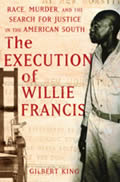
The Execution of Willie Francis, by Gilbert King, is a moving account that expounds on how discretion is written into law, and is protected by it, how deference to community standards may amount to following the rule of an imagined community, and the horrific realities of execution regardless of the wait or the means.
As King told the story, he frequently toggled between the story of Willie Francis and the history of the legal officials who shaped the last three years—a full sixth—of his short life. Through this sort of telling the author argued that the structure of Southern society made the execution of a black boy, who according to the record committed murder at the age of 15, inevitable. However, how King introduces some of these historical details rather abruptly, so that one moment the reader is focused on circumstances that immediately impacted Willie Francis’ welfare in 1948, and in the next moment the author has segued into a lengthy description of an execution that occurred over 50 years before. This leaves the impression of simultaneity, giving the sense that people are deluding themselves into thinking that the process of execution is any different in the time of Willie Francis than it was before. Indeed, it might involve more sophisticated technologies, but in the end it still was typified by the same racism, thuggish administration, and “imprecision” (read: painful, protracted deaths) as in the nineteenth century.
It was clearly written for a popular audience, and was a cross between true crime, history and a legal study. The chapters were short, and King structured them so that by the end of each chapter one was struck with a sense of all that was unresolved in a way that was evocative of a suspense novel. Gilbert King—a journalist—does not clearly, and systematically attribute each point to a particular source (possibly to make the text easier to read?). Nevertheless, his work contains rich historical detail, suggests an impressive survey of primary sources, and includes endnotes in which he records the sources that he consulted, and specifically notes where he drew quotations from. Though a transcript from Willie Francis’ trial was never made, he also demonstrated an interesting and impressive analysis of the minutes, and inferred therefrom that his counsel provided ineffective representation.
Nevertheless, I thought that the author might have better distinguished between the difference between legal proof and other standards of proof. Indeed, the author was wearing his barrister’s costume and poking holes in the prosecution’s case for the first two thirds of the book. When, in the last hundred pages, he shifted his perspective from one that doubted the culpability of Willie Francis in a homicide, to one that accepted Francis was responsible for the death of Andrew Thomas, it was disorienting. This shift might have been accomplished in more nuanced a way if the author bridged these two considerations with a discussion about the different kinds of homicide and culpability that attaches thereto, as well as the changing impression of sexual relationships between minors and men from the 1940’s to present day.
Additionally, King never really made explicit in his account that this was very much a story about white people, and about how white people perceive they treat black people. More particularly, it was written by a white non-Southerner about how he perceived white Southerners treated black people. How the author treats black people is at a remove. In terms of space in the text the white people in this story are definitely afforded the most, and the white and light-skinned heroes in this story are portrayed as morally exceptional. This is not just written into the subtext of the author’s lengthy descriptions of certain white characters acting for the black defendant despite the material consequences they might expect in a racist society. He also quotes a member of the NAACP who highlighted the significance of white allies’ sacrifices over those made by black activists. Having said this, this book does acknowledge the agency of racial minorities at this time, concluding the story with the image of a black boy instructing, and then comforting his tearful white lawyer.
No comments:
Post a Comment